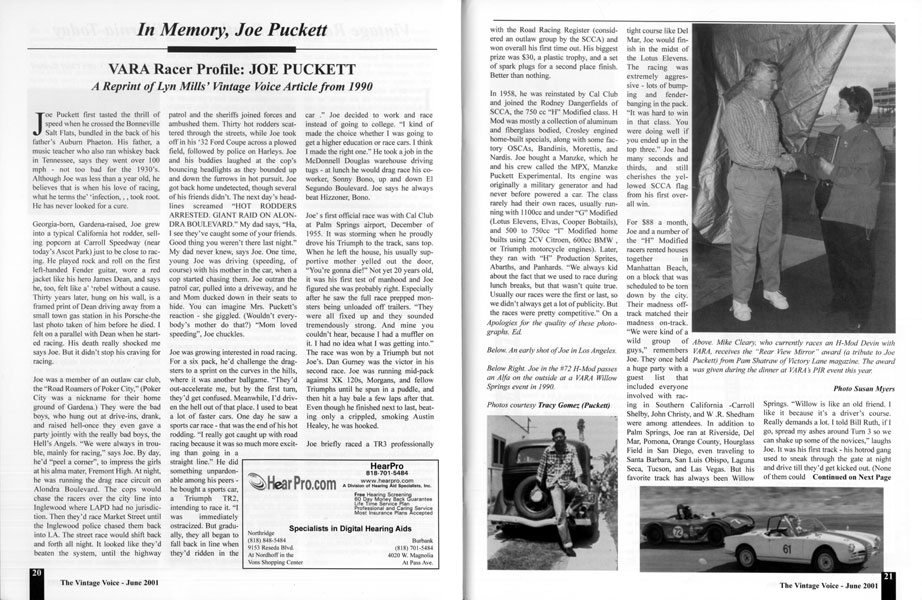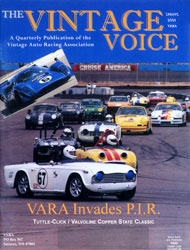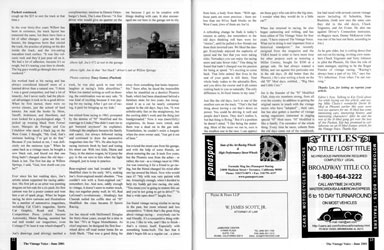
In Memory, Joe Puckett
VARA Racer Profile: Joe Puckett
A Reprint of Lynn Mills' Vintage Voice Article from 1990Joe Puckett first tasted the thrill of speed when he crossed the Bonneville Salt Flats, bundled in the back of his father's Auburn Phaeton. His father, a music teacher who also ran whiskey back in Tennessee, says they went over 100 mph -- not too bad for the 1930's. Although Joe was less than a year old, he believes that is when his love of racing, what he terms the 'infection'... took root. He has never looked for a cure.
Georgia-born, Gardena-raised, Joe grew into a typical California hot rodder, selling popcorn at Carroll Speedway (near today's Ascot Park) just to be close to racing. He played rock and roll on the first left-handed Fender Guitar, wore a red jacket like his hero James Dean, and says he, too, felt like a 'rebel without a cause.' Thirty years later, hung on his wall, is a framed print of Dean driving away from a small town gas station in his Porsche -- the last photo taken of him before he died. "I felt on a parallel when he started racing. His death really shocked me," says Joe. But it didn't stop his craving for racing.
Joe was a member of an outlaw car club, the "Road Runners of Poker City," (Poker City was a nickname for their home ground of Gardena.) They were the bad boys, who hung out at drive-ins, drank and raised hell -- once they even gave a party jointly with the really bad boys, the Hell's Angels. "We were always in trouble, mainly for racing," says Joe. By day, he'd "peel a corner," to impress the girls at his alma mater, Fremont High. At night, he was running the drag race circuit on Alondra Boulevard. The cops would chase the racers over the city line into Inglewood where LAPD had no jurisdiction. Then they'd race Market Street until the Inglewood police chased them back into L.A. The street race would shift back and forth all night. It looked like they'd beaten the system, until the highway patrol and the sheriffs joined forces and ambushed them. Thirty hot rodders scattered through the streets, while Joe took off in his '32 Ford Coupe across a plowed field, followed by police on Harleys. Joe and his buddie laughed at the cop's bouncing headlights as they bounded up and down the furrows in hot pursuit. Joe got back home undetected, though several of his friends didn't. The next day's headlines screamed, "HOT RODDERS ARRESTED. GIANT RAID ON ALONDRA BOULEVARD." My dad says, "Ha, I see they've caught some of your friends. Good thing you weren't there last night." My dad never knew, says Joe. One time, young Joe was driving (speeding, of course) with his mother in the car, when a cop started chasing them. Joe outran the patrol car, pulled into a driveway, and he and Mom ducked down in their seats to hide. You can imagine Mrs. Puckett's reaction -- she giggled. (Wouldn't everybody's mother do that?) "Mom loved speeding," Joe chuckles.
Joe was growing interested in road racing. For a six pack, he'd challenge the dragsters to a sprint on the curves in the hills, where it was another ballgame. "They'd out-accelerate me, but by the first turn, they'd get confused. Meanwhile, I'd driven the hell out of that place. I used to beat a lot of faster cars. One day he saw a sports car race -- that was the end of his hot rodding. "I really got caught up with road racing because it was so much more exciting than going in a straight line." He did something unpardonable among his peers -- he bought a sports car, a Triumph TR2, intending to race it. "I was immediately ostracized. But gradually, they all began to fall back in line when they'd ridden in the car."
Joe decided to work and race instead of going to college. "I kind of made the choice whether I was going to get a higher education or race cars. I think I made the right one." He took a job in the McDonnell Douglas warehouse driving tugs -- at lunch he would drag race his co-worker, Sonny Bono, up and down El Segundo Boulevard. Joe says he always beat Hizzoner, Bono.
Joe's first official race with with Cal Club at Palm Springs airport, December of 1955. It was storming when he proudly drove his Triumph to the track, sans top. When he left the house, his usually supportive mother yelled out the door. "You're gonna die!" Not yet 20 years old, it was his first tets of manhood and Joe figured she was probably right. Especially after he saw the full race-prepped monsters being unloaded off trailers. "They were all fixed up and they sounded tremendously strong. And mine you couldn't hear, because I had a muffler on it. I had no idea what I was getting into." The race was won by a Triumph, but not Joe's. Dan Gurney was the victor in his second race. Joe was running mid-pack against XK120s, Morgans, and fellow Triumphs until he spun in a puddle, and then hit a hay bale a few laps after that. Even though he finished next to last, beating only a crippled, smoking Austin Healey, he was hooked.
Joe briefly raced a TR3 professionally with the Road Racing Register (considered an outlaw group by the SCCA) and won overall his first time out. His biggest prize was $30, a plastic trophy, and a set of spark plugs for a second place finish. Better than nothing.
In 1958, he was reinstated by Cal Club and joined the Rodney Dangerfields of SCCA, the 750cc "H" Modified class. H Mod was mostly a collection of aluminum and fiberglass bodied, Crosley engined home-built specials, along with some factory OSCA's, Bandinis, Morettis, and Nardis. Joe bought a Manzke, which he and his crew called the MPX, Manzke Puckett Experimental. Its engine was originally a military generator and had never before powered a car. The class rarely had their own races, usually running with 1100cc and under "G" Modified (Lotus Elevens, Elvas, Cooper Bobtails), and 500 to 750cc "I" Modified home builts using 2CV Citroen, 600cc BMW or Triumph motorcycle engines). Later, they ran with "H" Production Sprites, Abarths, and Panhards. "We always kid about the fact that we used to race during lunch breaks, but that wasn't quite true. Usually our races were the first or last, so we didn't always get a lot of publicity. But the races were pretty competitive." On a tight course like Del Mar, Joe would finish in the midst of the Lotus Elevens. The racing was extremely aggressive -- lots of bumping and fender-banging in the pack. "It was hard to win in that class. You were doing well if you ended up in the top three." Joe had many seconds and thirds, and still cherished the yellowed SCCA flag from his first overall win.
For $88 a month, Joe and a member of the "H" Modified racers reneted houses together in Manhattan Beach, on a block that was scheduled to be torn down by the city. Their madness off-track matched their madness on-track. "We were kind of a wild group of guys," remembers Joe. They once held a huge party with a guest list that included everyone involved with racing in Southern California -- Carroll Shelby, John Christy, and W. R. Shedham were among attendees. In addition to Palm Springs, Joe ran at Riverside, Del Mar, Pomona, Orange County, Hourglass Field in San Diego, even traveling to Santa Barbara, San Luis Obispo, Laguna Seca, Tucson, and Las Vegas. But his favorite track has always been Willos Springs. "Willow is like an old friend. I like it because it's a driver's course. Really demands a lot. I told Bill Huth, if I go, spread my ashes around Turn 3 so we can shake up some of the novices," laughs Joe. It was his first track -- his hotrod gang used to sneak through the gate at night and drive till they'd get kicked out. (None of them could cough up the $25 to rent the track at that time.)
In the over thirty-five years Willow has been in existence, the track layout has remained the same, but there have been a lot of other changes -- gone are the out houses, the dangerous berm that circled the track, the practice of pitting on the dirt inside the track, and the tire-eating macadam track surface. "It was like volcanic roack and they'd just pour oil on it. We had a lot of adhesion, because it's so rough, but it's tearing your tires to shreds. The big guys would go through tires every weekend."
Joe worked hard at his racing and has always considered himself more of a learned driver than a natural one. "I think I was a good competitor, and had a lot of tenacity -- but I never really had the physical advantages it took to be a good driver. When he first started, there were no novice classes, just the school of hard knocks. Joe read the books by Moss, Taruffi, Jenkinson, and Hawthorn, and even looked for a psychological edge. "I picked up wearing black from Ferrari racer, Marquis de Portago and Ces Critchlow who raced a black Jag on the West Coast. I thought, "My God, that's ominous looking. I've got to do that." Because if you looked at me, I was definitely not the ominous type." When he came back as a vintage racer, he bought a new black suit, and found out that one thing hadn't changed since the old days -- black is hot. The first hot day at Willow Springs, I said, "God, how dumb can you be?"
Ever since his hot rodding days, Joe's artistic talent supported the racing addiction. His first job as an artist was painting dragons on hot rods for a six pack; his first cartoon was for a poster contest and won him a set of spark plugs. When he began racing, he drew cartoons and illustrations for a number of automotive magazines, including Cal Club's magazine, Sports Car Graphic, Road and Track, Competition Press (which became Autoweek), Motor Racing, assorted hot rod and model car magazines, even Coinage (At least it was wheel-shaped").
Joe's drawings (and driving) merited a complimentary mention in Dennis Ortenburger's book, The Lotus Eleven: "A fine driver who would give no quarter on the track, he was also quick to roar with laughter at racing's little absurdities." When Joe started writing as well as drawing, the combination was an easy sale. "It was kind of exciting because it was paying for my racing. After I got out of racing, it paid for bringing up my kids."
Joe retired from racing in 1963, prompted by the demise of "H" Modified and his marriage to Linda ("She didn't want me to get bumped anymore," he explains). Although the emphasis became his family and career, Joe always followed racing and continued to draw for automotive magazines into the '70's. He also kept his racing instincts fresh by heel and toeing his street car. With two kids, Diana and Tracy, in the station wagon, he'd jump the guy in the car next to him when the light changed, just to keep in practice.
Rear-engined cars had invaded the "H" Modified class in the early '60's, making Joe's front-engined model obsolete. "You couldn't win with a front-engined car," remembers Joe. And now, oddly enough in vintage, it doesn't seem to matter much, they run together retty well. In '65, Red LeGrand's revolutionary, blindingly fast Cheetah nailed the coffin shut on "H" Modified -- the class became D Sports Racing.
Joe has stayed with McDonnell Doughlas for thirty-three years, except for a stint in the late '70's at Vogue Motorhomes. As chief engineer, he designed the first four-wheel drive off-road motor home for an Arab Shiek. "That was a good thing for me because I got to be creative with things dealing with cars. It also encouraged me out here in the garage not to shy away from something that looks impossible." Soon after, he faced the impossible when he stumbled on a derelict Phoenix Saab, which had been abandoned behind a furniture store for two years. Joe recognized it as a car he nearly competed against in the old days. Says Joe, "It was unbelievably fast on the straightaway, but the cooling didn't work and the thing just handgrenaded." Now it was (mercifully) engineless, its hoses were rotted, and there was a dead rat in the gas tank. Nonetheless, he couldn't resist a bargain when the store owner said, "Just get it out of here."
Joe evicted the street cars from his garage and with the help of some friends, set about restoring the car. It took five years, but the Phoenix rose from the ashes -- or rather the rust -- as a vintage racer in 1984. Joe was restoring it for a friend to go racing, but the friend changed his mind after one lap around the block. Now who would race it? "My wife was very patient with me. Amazingly enough, when I decided to help my buddy get into racing, she said, "You mean you're going to restore this car and you're not going to get to drive?" "Is that a wide open door?" laughs Joe.
Joe found vintage racing similar to racing in the past, but more relaxed and less competitive. "I think that's the great thing about vintage racing -- everybody can be really friendly. It's a competitive thing within you. I like to win, and I like to finish -- that's a victory in itself. Especially with something home-built. The fact that it didn't begin life as a regular car ...a piece from here, a body from there. "With age, those parts are more precious -- there are less than ten 841cc Saab blocks on the West Coast, (two of them are Joe's).
A refreshing change he finds is today's interest in safety. Joe remembers in the old days thinking roll bars were for "sissies," until he pulled a few freinds out from their inverted cars. We liked the danger. Everybody enjoyed the euphoria of speed and the fact that you were taking risks. Nowadays you can enjoy the raing more and take fewer risks." One thing he found that hadn't changed was his passion for being at speed. "It's exciting to come back. That little animal that lives in the seat of your pants is still there. Your whole body wakes to the adrenalin flow, and you drive the course and it all comes rushing back to you so naturally. The only difference is, bi-focal lenses in my case."
Just like the old days, Joe's is one of the smallest on the track. "That's the bad thing about having a car that's down on power. You could be driving it well and people don't know. They don't realize it, but that thing is flying." But it's a position he doesn't mind. "I like being the underdog. Most of the races we run in, ours is the smallest one in the race. I can appreciate those guys who can drive the big ones. I wonder what they would do in a little car?"
When Joe returned to racing, he also began cartooning and writing, and has been editor of The Vintage Voice for four years. "I have enjoyed The Vintage Voice. What we're doing is real important from a historical standpoint." Joe recently resigned from the magazine and the VARA board in order to have more time for other projects such as restoring a Miller Crosley, bought for $500 at a garage sale. He has always wanted a Miller, and ran against this particular one in the old days. (It did better than the Phoenix.) He's also writing a book on the old "H" Mod days, entitled "Big Men and Little Cars."
Joe is the founder of the "H" Modified Club, sixty-six members strong, from all over the country. In addition to getting the original racers in touch with the vintage racers who have "adopted" their cars. Joe has also gotten a number of vintage racing organizers interested in staging special "H" Mod races. "'H' Modified is like a family. I'm caretaker of the whole thing. Every time he races, cohorts from the old days come out of the woodwork.
Joe had raced with several current vintage racers including Al Schorkink Stan Bucklein (both now race the same cars they did in the old days), Chuck Tsigounis, and Art Evans. He also ran against Driver's Connection instructor, ex-Bugeye racer, Danny McKeever (who was one of the best out there, according to Joe).
As he gets older, Joe is cutting down (but not out) on his racing, inviting crew members Chuck Tsigounis and Terry Johnson to pilot the Phoenix. He likes the role of team manager, aspiring to be the Roger Penske of vintage racing. "Racing's always been a part of my life," says Joe. "It's infectious. Even when I'm not running."


